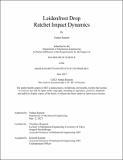| dc.contributor.advisor | Mouterde, Timothée | |
| dc.contributor.author | Ramesh, Nathan | |
| dc.date.accessioned | 2023-09-13T18:06:17Z | |
| dc.date.available | 2023-09-13T18:06:17Z | |
| dc.date.issued | 2023-06 | |
| dc.date.submitted | 2023-09-07T19:28:04.204Z | |
| dc.identifier.uri | https://hdl.handle.net/1721.1/152120 | |
| dc.description.abstract | A drop deposited on a sufficiently hot substrate generates its own vapor cushion preventing contact with the surface. This vapor layer is responsible for the low friction and long lifetime of the drop. Falling water droplets will even bounce on their own vapor layer. By varying the geometry of a surface at the micro-scale, it is possible to control the movement of impacting droplets in this Leidenfrost state. We propose a model for the behavior of droplets impacting a micro scale ratchet structure. In particular, we theorize that surface roughness can lead to an inconsistent vapor layer, allowing for propulsion resulting from contact boiling. Additionally, pressure differences in the vapor layer can drive a convective vapor flow that can drag the drop along. In this study, we examine the horizontal velocity of water dropped on a ratchet surface with varying temperature, impact velocity, and ratchet geometry. We provide a new explanation—involving both propulsion from contact boiling as well as convective vapor flow—for why droplets move in the direction they do. | |
| dc.publisher | Massachusetts Institute of Technology | |
| dc.rights | Attribution 4.0 International (CC BY 4.0) | |
| dc.rights | Copyright retained by author(s) | |
| dc.rights.uri | https://creativecommons.org/licenses/by/4.0/ | |
| dc.title | Leidenfrost Drop Ratchet Impact Dynamics | |
| dc.type | Thesis | |
| dc.description.degree | S.B. | |
| dc.contributor.department | Massachusetts Institute of Technology. Department of Mechanical Engineering | |
| mit.thesis.degree | Bachelor | |
| thesis.degree.name | Bachelor of Science | |
